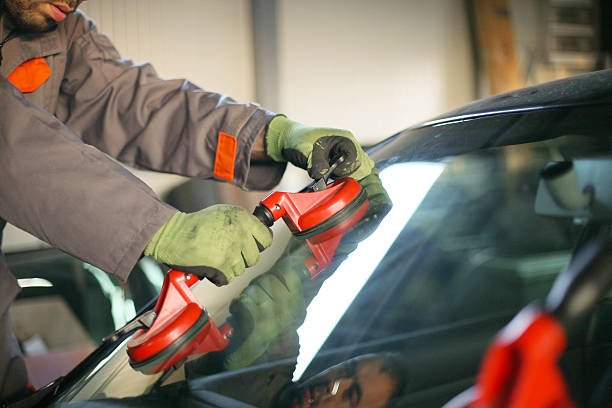
Quick Service Auto Glass
Clear Vision Ahead - Your Woodland Hills Windshield Repair Pros
(818) 264-4589
Clear Vision Ahead - Your Woodland Hills Windshield Repair Pros
(818) 264-4589Your windshield, a crucial part of your vehicle's safety, is more vulnerable to stress cracks than you might think, especially when faced with temperature fluctuations. These cracks can impair visibility and compromise structural integrity.
In this guide, we'll share essential tips to help you protect your windshield from damage and prevent stress cracks, ensuring both safety and clarity on the road.
(818) 264-4589To understand the causes of windshield stress cracks, consider temperature changes as the primary culprit. When your car is exposed to extreme temperature fluctuations, such as going from a hot summer day to a cold winter night, the glass of your windshield expands and contracts. This constant expansion and contraction can lead to stress on the glass, eventually causing small cracks to form.
Additionally, if you have a pre-existing chip or crack in your windshield, temperature changes can exacerbate the problem and cause it to spread further.
It's important to note that temperature changes aren't the only factor that can cause stress cracks in windshields, but they do play a significant role. By understanding the impact of temperature changes, you can take preventative measures to minimize the risk of stress cracks in your windshield.
To further safeguard your windshield from damage, it's advisable to explore professional windshield repair services.
To keep your windshield free from debris and ensure optimal visibility, regularly clean and clear it of any dirt, dust, and other particles. A dirty windshield can be a major safety hazard, as it can hinder your ability to see the road.
When dirt and dust accumulate on your windshield, they can create a hazy film that distorts your vision, especially when sunlight hits it at certain angles. Additionally, particles on your windshield can cause scratches and damage to the glass, which can compromise its structural integrity and increase the risk of stress cracks.
To clean your windshield effectively, use a glass cleaner and a soft cloth or sponge to gently remove any dirt or grime. Be sure to also clean the wiper blades regularly, as they can accumulate dirt and debris that can scratch the windshield during operation.
Park your vehicle in shaded areas to protect your windshield from temperature changes. When your car is exposed to direct sunlight for long periods, the extreme heat can cause the glass to expand rapidly, putting it at risk of stress cracks. By parking in shaded areas, you can minimize the impact of temperature fluctuations on your windshield.
Shaded areas protect from the intense heat of the sun, reducing the chances of sudden temperature changes that can lead to cracks. Additionally, parking in the shade can help maintain a more stable temperature inside your vehicle, preventing the glass from expanding and contracting too rapidly.
Monitor the ambient temperature around your vehicle to prevent sudden changes that can stress your windshield. Sudden shifts in temperature can cause your windshield to expand or contract rapidly, leading to stress cracks.
To avoid this, be aware of the temperature outside before starting your car or blasting the air conditioning or heating. If the weather is extremely cold or hot, gradually adjust the temperature inside your vehicle to match the outside temperature.
Additionally, avoid parking your car in direct sunlight, as this can cause the temperature inside your vehicle to rise quickly. Instead, try to find shaded areas to park in to minimize the risk of sudden temperature changes and potential windshield stress cracks.
If you want to protect your windshield from stress cracks caused by temperature changes, using windshield covers or sunshades can be an effective solution. These covers and sunshades act as barriers, preventing direct exposure to extreme temperatures, which can lead to stress cracks.
When you park your car in direct sunlight for extended periods, the intense heat can cause the glass to expand rapidly, creating stress on the windshield surface. By using a windshield cover or sunshade, you can block out the sun's rays and reduce the amount of heat that reaches your windshield. This helps to maintain a more stable temperature, minimizing the risk of stress cracks.

Additionally, windshield covers and sunshades can also help to protect your car's interior from harmful UV rays, keeping it cooler and preventing damage to your dashboard and upholstery.
Invest in a good quality cover or sunshade that fits your windshield properly, ensuring maximum protection for your vehicle.
For quick patch-up tips to fix windshield cracks, start by thoroughly cleaning the area around the crack with a glass cleaner to remove any dirt or debris. Then, apply a windshield repair kit according to its instructions. These kits usually include a resin that fills the crack and prevents it from spreading. Keep in mind, that this is a temporary solution, and for larger cracks or those in the driver's line of vision, it's best to seek professional help as soon as possible
So, remember to take these precautions to prevent stress cracks in your windshield.
Website: https://www.quickserviceautoglass.com/
Phone No: (818) 264-4589
Address: 22035 Burbank Blvd Ste 206, Woodland Hills, CA 91367
Working Hours: Monday to Sunday 7 AM to 9 PM